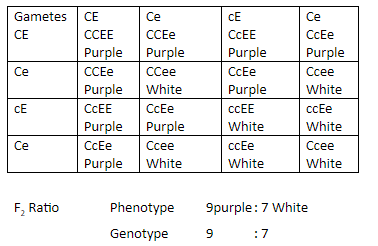
In complementary gene interaction genotypic ratio is
Answer
497.1k+ views
Hint: Complementary genes is a group of genes that complement to or contribute to a single characteristic where both genes can mask the effect of the other.
Complete answer
Complementary genes:- Two independent parts of genes, which interact to produce a trait together, but each dominant gene alone does not show its effects, are called complementary genes.
Example: when white flowered sweet peas are crossed they produce plants with purple flower F1 plants on inbreeding or self-fertilization give F2 generation in a ratio of a purple flowered to 7 white flowered plants.
Explanation:- Two pairs of genes located in different chromosomes regulate the flower colour in their varieties of sweet peas. One dominant gene, say C, controls the synthesis of the raw material for the purple pigment and another dominant gene, say E, controls the formation of an enzyme that converts the raw material into purple pigment.
At least one C gene and one E gene must be present to produce purple flowers; the absence of any one or both results in white flowers.

A cross between two white flowered varieties, one is genotypically ccEE and the other CCee. The former lack genes for the formation of the raw material, and the latter lack genes for the formation of enzymes needed to change the raw material into the final pigment. Hence both are white coloured. The absence of any one or both results in white flowers.
In CcEE and CCee, former lacks the gene for the formation of the raw material and latter lacks the gene for the formation of enzymes needed to change the raw material into the final pigment. Hence both are white coloured.
Hence in F1 generation, all are phenotypically purple, as they carry a gene for the raw material as well as a gene for the enzyme required to convert the raw material into the pigment.
In F2 generation of these cross between two purple-flowered plants of F1 generation, the Phenotypic ratio is
But the genotypic ratio is
Hence, genotypic ratio is
The correct option is ‘D’,
Note:Several varieties of white flowered sweet peas (Lathyrus odoratus) are known and a cross between most of these varieties yield only white flowered plants. However, a cross between two particular white flowered varieties produces plants with purple flowers. F2 generation in the ratio of
Complete answer
Complementary genes:- Two independent parts of genes, which interact to produce a trait together, but each dominant gene alone does not show its effects, are called complementary genes.
Example: when white flowered sweet peas are crossed they produce plants with purple flower F1 plants on inbreeding or self-fertilization give F2 generation in a ratio of a purple flowered to 7 white flowered plants.
Explanation:- Two pairs of genes located in different chromosomes regulate the flower colour in their varieties of sweet peas. One dominant gene, say C, controls the synthesis of the raw material for the purple pigment and another dominant gene, say E, controls the formation of an enzyme that converts the raw material into purple pigment.
At least one C gene and one E gene must be present to produce purple flowers; the absence of any one or both results in white flowers.

A cross between two white flowered varieties, one is genotypically ccEE and the other CCee. The former lack genes for the formation of the raw material, and the latter lack genes for the formation of enzymes needed to change the raw material into the final pigment. Hence both are white coloured. The absence of any one or both results in white flowers.
In CcEE and CCee, former lacks the gene for the formation of the raw material and latter lacks the gene for the formation of enzymes needed to change the raw material into the final pigment. Hence both are white coloured.
Hence in F1 generation, all are phenotypically purple, as they carry a gene for the raw material as well as a gene for the enzyme required to convert the raw material into the pigment.
In F2 generation of these cross between two purple-flowered plants of F1 generation, the Phenotypic ratio is
But the genotypic ratio is
Hence, genotypic ratio is
The correct option is ‘D’,
Note:Several varieties of white flowered sweet peas (Lathyrus odoratus) are known and a cross between most of these varieties yield only white flowered plants. However, a cross between two particular white flowered varieties produces plants with purple flowers. F2 generation in the ratio of
Latest Vedantu courses for you
Grade 10 | CBSE | SCHOOL | English
Vedantu 10 CBSE Pro Course - (2025-26)
School Full course for CBSE students
₹37,300 per year
Recently Updated Pages
Master Class 9 General Knowledge: Engaging Questions & Answers for Success

Master Class 9 English: Engaging Questions & Answers for Success

Master Class 9 Science: Engaging Questions & Answers for Success

Master Class 9 Social Science: Engaging Questions & Answers for Success

Master Class 9 Maths: Engaging Questions & Answers for Success

Class 9 Question and Answer - Your Ultimate Solutions Guide

Trending doubts
State and prove Bernoullis theorem class 11 physics CBSE

What are Quantum numbers Explain the quantum number class 11 chemistry CBSE

Who built the Grand Trunk Road AChandragupta Maurya class 11 social science CBSE

1 ton equals to A 100 kg B 1000 kg C 10 kg D 10000 class 11 physics CBSE

State the laws of reflection of light

One Metric ton is equal to kg A 10000 B 1000 C 100 class 11 physics CBSE




